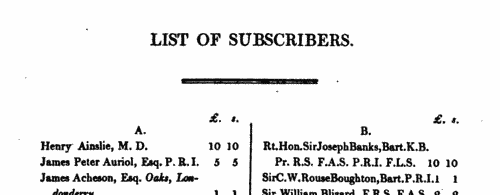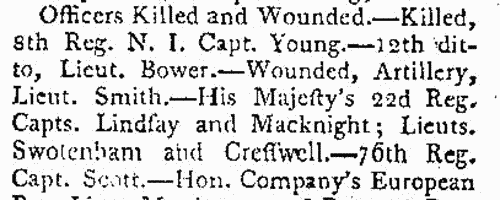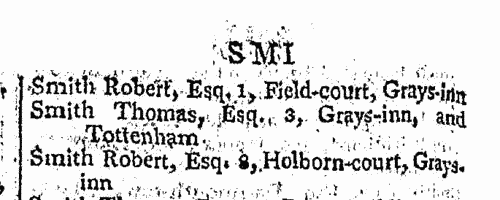Add this eBook to your basket to receive access to all 478 records. Our indexes include entries for the spelling cresswell. In the period you have requested, we have the following 478 records (displaying 91 to 100): These sample scans are from the original record. You will get scans of the full pages or articles where the surname you searched for has been found. Your web browser may prevent the sample windows from opening; in this case please change your browser settings to allow pop-up windows from this site.  Masters of apprentices registered in Leicestershire
(1798) Masters of apprentices registered in Leicestershire
(1798)
Apprenticeship indentures and clerks' articles were subject to a 6d or 12d per pound stamp duty: the registers of the payments usually give the master's trade, address, and occupation, and the apprentice's name, as well as details of the date and length of the apprenticeship. There are central registers for collections of the stamp duty in London, as well as returns from collectors in the provinces. These collectors generally received duty just from their own county, but sometimes from further afield. The indentures themselves can date from a year or two earlier than this return. (The sample entry shown on this scan is taken from a Bristol return. Each entry has two scans, the other being the facing page with the details of the indenture, length of service, and payment of duty.) IR 1/69 | Sample scan, click to enlarge

|  Apprentices and clerks
(1799) Apprentices and clerks
(1799)
Apprenticeship indentures and clerks' articles were subject to a 6d or 12d per pound stamp duty: the registers of the payments usually give the master's trade, address, and occupation, and the apprentice's name, as well as details of the date and length of the apprenticeship. 11 March to 31 December 1799. IR 1/38 | Sample scan, click to enlarge

| Freemen of Canterbury by Apprenticeship
(1392-1800)
No man or woman could trade in the city of Canterbury without having obtained 'freedom' of the city, unless they paid an annual fee to do so. Admissions of freemen were recorded on the Chamberlains' Accounts of the city, which were prepared annually from Lady Day (25 March) to Lady Day until 1752, and thereafter each set runs from 1 January to 31 December. The accounts for 1392 are incomplete, but thereafter until 1800 there is a complete series except for the years 1455 to 1457 and the year 1552-3. Joseph Meadows Cowper, Honorary Librarian to the Corporation, produced this extract of the names from 1392 to 1800, and the volume was privately printed in 1903. There are five groups of freemen: those who obtained freedom after serving out an apprenticeship to a freeman; the children of freemen; those who married a freeman's daughter; those who claimed freedom by 'redemption', i. e. by purchase; and those who were honoured by a gift of the freedom from the Mayor and Court of Aldermen. Cowper published his lists divided into the five categories: the sample scan is from the list of those who obtained freedom by marriage. This is the index to those who gained their freedom by apprenticeship. | Sample scan, click to enlarge

|  Apprentices registered in Lincolnshire
(1800) Apprentices registered in Lincolnshire
(1800)
Apprenticeship indentures and clerks' articles were subject to a 6d or 12d per pound stamp duty: the registers of the payments usually give the master's trade, address, and occupation, and the apprentice's name, as well as details of the date and length of the apprenticeship. There are central registers for collections of the stamp duty in London, as well as returns from collectors in the provinces. These collectors generally received duty just from their own county, but sometimes from further afield. The indentures themselves can date from a year or two earlier than this return. (The sample entry shown on this scan is taken from a Bristol return. Each entry has two scans, the other being the facing page with the details of the indenture, length of service, and payment of duty.) IR 1/69 | Sample scan, click to enlarge

| Deaths, Marriages, and Marine Accidents
(1802-1803)
Death notices and obituaries, marriage and birth notices, general news and marine accidents (usually naming the unfortunate captain), as reported in the Monthly Register and Encyclopedian Magazine. Includes some marriages and deaths from Ireland, Scotland and abroad.
| Sample scan, click to enlarge

| Subscribers to Zoonomia
(1804)
'Popular Lectures on Zoonomia, or The Laws of Animal Life, in Health and Disease' by Thomas Garnett, M.D., Member of the Royal College of Physicians, London; of the Royal Irish Academy; of the Royal Medical Society of Edinburgh; Honorary Member of the Board of Agriculture; Fellow of the Linnean Society; Member of the Medical Society, London; and of the Literary and Philosophical Society of Manchester, formerly Professor of Natural Philosophy and Chemistry in the Royal Institution of Great Britain, was published in London, from the press of the Royal Institution of Great Britain, in 1804, for the benefit of the author's children by his executors. | Sample scan, click to enlarge

| Deaths, Marriages, News and Promotions
(1805)
Death notices and obituaries, marriage and birth notices, civil and military promotions, clerical preferments and domestic occurrences, as reported in the Gentleman's Magazine. Mostly from England and Wales, but items from Ireland, Scotland and abroad.
| Sample scan, click to enlarge

| Hospital governors, staff and officials
(1805)
Governors, surgeons, officers and clerks of several hospitals, both official and charitable, are listed in Holden's Triennial Directory of 1805 to 1807: St Bartholomew's in West Smithfield; Christ's, in Newgate Street; Bridewell and Bethlehem on New Bridge Street; St Thomas's, in Southwark; the Royal Hospital in Chelsea; the London Hospital in Whitechapel Road; Guy's, in Southwark; St George's, on Hyde Park Corner; St Luke's, for lunatics, in Old Street; and the Royal Hospital in Greenwich. | Sample scan, click to enlarge

| Inhabitants of London
(1805)
Holden's Triennial Directory for 1805 to 1807 includes this 'London Alphabet. Private Residences'. About 10,000 people are recorded. | Sample scan, click to enlarge

| London city aldermen and officials
(1805)
The city of London already comprised a smaller area than London as a whole. The city was governed by the Lord Mayor and aldermen. Each aldermen represented a ward, but also had to be a citizen, i. e., a member of a city company. The aldermen, their wards and companies, and the deputies and common council of the respective wards, with their occupations and addresses are listed in Holden's Triennial Directory of 1805 to 1807. This list also covers the members of the various committees involved in governing the city, governors of city institutions, and local government officials and officers. | Sample scan, click to enlarge

|
Research your ancestry, family history, genealogy and one-name study by direct access to original records and archives indexed by surname.
|












